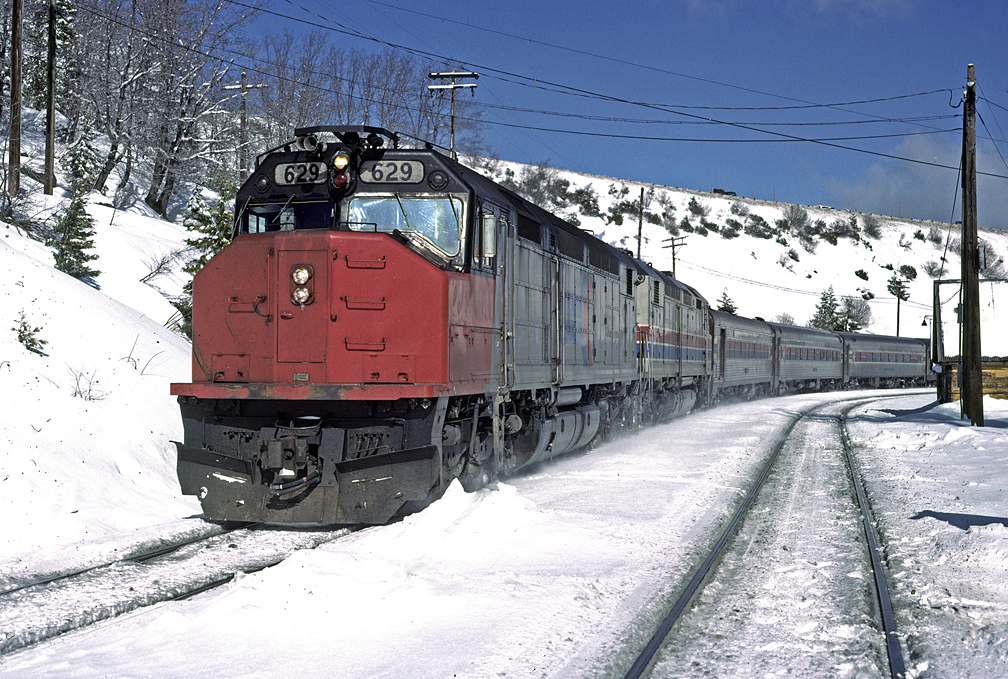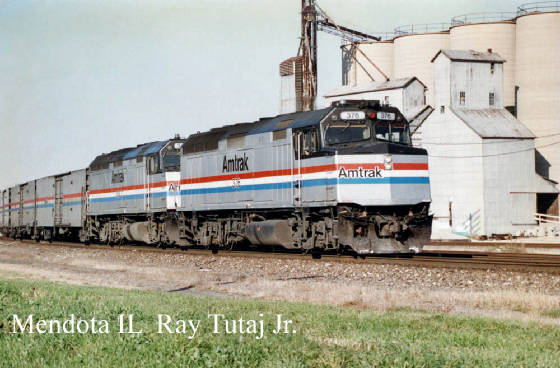In the beginning, 1971, Amtrak used whatever passenger equipment they had obtained from the railroads as a part of the deal of no longer requiring the railroads to provide passenger service. This was known as the "rainbow" era.
 |
| Photo by Michael Matalis, used with permission |
 |
| Amtrak: Phase I, introduced in 1972, on a SDP40F. Heritage unit is #156. |
Amtrak's first paint scheme, or Phase I, was introduced for the first locomotive design purchased by Amtrak -- EMD SDP40F. This 6-axle (C-C) design was for long distance passenger trains. 150 were built between 1973 and 1974. They used the 16-cylinder turbocharged 645E3 that generated 3,000 hp with a 57:20 gearing that allowed 100 mph. This design was based on EMD's SD40-2 freight locomotive and was designed for easy conversion to freight locomotives should Amtrak cease operation. They included a steam generator because most of the passenger cars they inherited were built during the steam era. (The E units that had been used by the railroads for passenger trains also had steam generators.)
 |
| Copyleft: Photo by Drew Jacksich from San Jose, CA, The Republic of California. |
R. Craig caught Phase I Heritage Unit #156 in Rock Island, IL.
 |
| Amtrak: Phase II, introduced in 1975, on a F40PH. Heritage unit is #66. |
EMD built the 4-axle (B-B) F40PH from 1975 to 1992 and MK Rail and MotivePower Industries built it from 1991 to 2000. The Phase II paint scheme extended the stripes that were being used on the passenger cars to the engine, including the nose. Charles J. Freericks caught Phase II Heritage Unit #66 in California.
The FP40PH was intended for short- to medium-length trains on Amtrak's shorter routes. It was also used by many commuter trains. But since it also had 3,000 hp (later 3,200 hp), it proved it could handle the long-distance trains, and it replaced the SDP40Fs by 1985. The main reason the SDP40Fs were replaced was that they rode rough and they had derailments. Because Amtrak specified a hollow bolster for the trucks to reduce their weight to help compensate for the extra weight of the steam generation equipment (including the water tanks), many suspected the trucks were the cause of the derailments. Later testing by EMD and FRA concluded that the light baggage car that followed the heavy locomotives was the cause of the derailments because the car caused harmonic vibrations. Another reason the SDP40Fs were replaced is that they needed to be converted from steam generation to Head-End Power because the passenger cars were being replaced with new cars that used electricity instead of steam. F40PHRs were built with parts from traded-in SDP40Fs. (SDP40F, F40PH, HT-C bolsters)
 |
| Amtrak: Phase III, introduced in 1979, on a F40PH. Heritage unit is #145. |
Phase III changed the pattern of the strips from three skinny white stripes to one wide white stripe. When first introduced, the P42DC used a variant of this scheme. Specifically the white stripe was skinner and the red and blue stripes were darker.
Charles J. Freericks caught Heritage Unit #145 in California. I asked for permission to use some additional Phase III photos.
 |
| Boston MA South Station, Photo by Douglas Weitzman, used with permission |
 |
| Photo by Ray Tutaj Jr. from Grain Elevators, used with permission |
 |
| Amtrak: Phase IV, introduced in 1993, on a P42. Heritage unit is #184. |
Phase IV was a rather radical departure from previous liveries. Geno Dailey caught F40PH 406 repainted in Phase IV.
 |
| Photo by Michael Matalis, used with permission |
On Christmas 2014, Michael caught Amtrak heritage #184 leading inbound (eastbound) Southwest Chief - Train #4 in Westmont, IL.
 |
| Photo by Michael Matalis, used with permission |
 |
| In summary, Photo by Matt Donnelly |
Also, the intro picture in a GE article concerning the P42 Genesis locomotive includes the Phase II and IV Heritage Units.
The Acela had some other liveries, but since I'm a Midwesterner, I'm skipping those. In addition to the four 40th Anniversary Heritage Units, the units that pulled the display train, #822 and F40PH #406, also had a special livery. Mike Matalis grabbed a couple of shots of #822 at the Fairview Ave. crossing in Downers Grove, IL on Feb. 9, 2015 leading the California Zephyr, Train #5.
 |
| Photo by Michael Matalis, used with permission |
 |
| Photo by Michael Matalis, used with permission |
 |
| Photo by Michael Matalis, used with permission |
On Nov. 11, 2014, Mike caught the "cabbage car" (combination cab car and baggage car) 90368 on the inbound Illinois Zephyr. It was a conversion of a F40PHR and retained its Phase III livery. The motive power is on the other end of the train. I thought the use of the cabbage car was to run the in-state trains like a push-pull commuter train. Specifically, the train does not have to be turned at the terminal ends. But this works only if the seats are flippable. Since flippable seats are not comfortable, I wondered if I was right about the Illini Zephyr being run in a push/pull mode. So I asked about it on a Facebook group, and I learned that half of the seats face one way and the other half face the other way. So the seats do not have to be flippable to operate in a push-pull manner.
Update: Siemens is making new locomotives for state subsidized services.
 |
| Photo by Mike Matalis, used with permission |
No comments:
Post a Comment